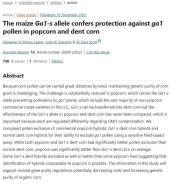Phil Stevens wrote:....I was under the impression that it was a Pandora's box situation and that you had to be quite a distance away from any commercial fields to still be in a "safe zone." So it seems that the entire midwest is suspect.....
I also like use of the Pandora's Box metaphor for the situation, but for an additional reason and that is the issue of what constitutes 'contamination'. To take one of the easier examples, early generation GMO for an arbitrary 'trait X' would have had the trait that benefited the farming operation on some level linked, physically, to a separate trait for antibiotic resistance as a consequence of the assembly process to produce that GMO line. It made it rather easy then for a testing service to detect the DNA for the 'new trait' as well as that for the antibiotic resistance still linked to the new trait. But if the chromosome harboring that module gets crossed into, say, a garden crop of the same species or a closely related weed species, it *can* and likely *will* begin undergoing mutation if there is no selective advantage now being conferred by that module in its new genome. If, for example, the 'trait' in question was stunting the height of commercial corn in order to be more easily harvested by a large combine and *if* the home gardener happened to want taller corn to keep the cobs higher on the stalk, then that stunting trait, over time, would start to drop out of your seed collection year after year as you avoided keeping seed from the stunted stalks. And since no known selection is occurring at the antibiotic resistance gene, it too will accumulate mutations over time just by chance. Let's not forget as well that mutations are not always just small changes, but can be deletions....wholesale removal of chunks of DNA by the plant's genome maintenance mechanisms.
And this is where the issue gets quite murky: Because how much DNA remaining from the module is enough to call it 'contamination'? In the case above, a few mutations in the right locations on the module would be sufficient to render the stunting gene 'inoperative' and the plants harboring the inactive copy would be tall. Seed saved from that plant would have an inactive stunting gene, but its DNA would still be there, albeit in mutated form. It's likely that most genetic testing services are just looking for small snippets of the module DNA when they test and give that a score of 'positive'.....and fair enough if that's enough for the customer to wish to jettison their seed stock. (The newer gene sequencing technologies that have emerged from the human genome sequencing projects globally are massively reducing the cost of whole genome sequencing of organisms: Easily the genetic testing services in question soon will be sequencing the entire genome of a received sample and looking for the presence of cross-pollinated genes in question using these methods.) But at the other extreme are 'gene edited' crops---considered non-GMO in the US if I'm not mistaken, but still under regulation in the EU. In these cases, it would be nearly impossible to determine if the change in the DNA was a result of natural variation or something put there deliberately through laboratory procedure.
No clear answers here, but it will be an issue to deal with as gene flow from modified crops to unmodified crops and to wild species continues to occur and as those gene modules 'degrade'....genetically speaking.....over time in their new background genomes.






 5
5




 9
9




 3
3




 1
1





 8
8




 4
4




 4
4





 6
6











 6
6









